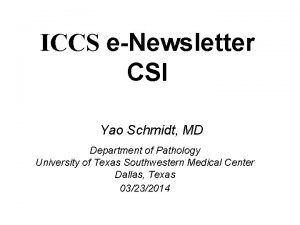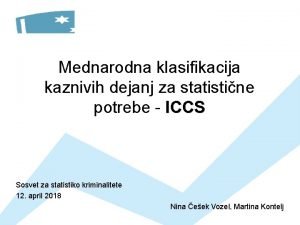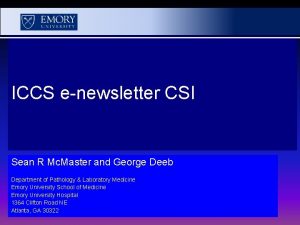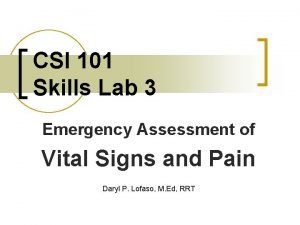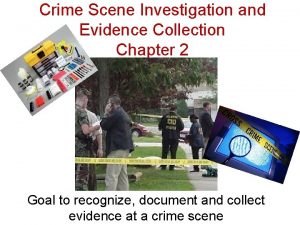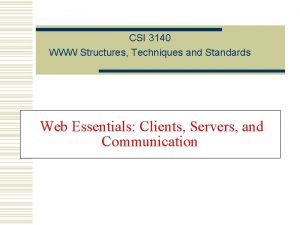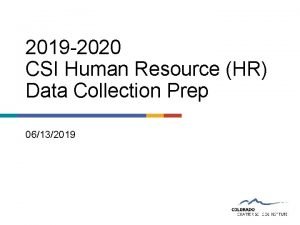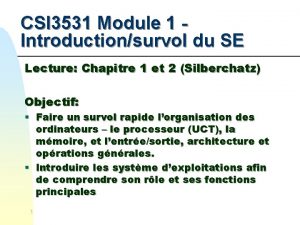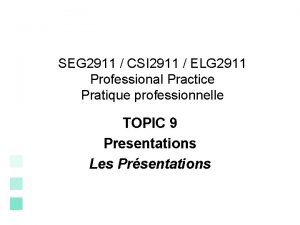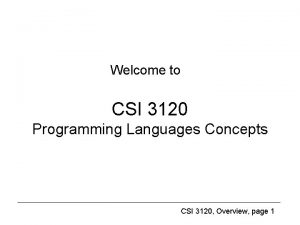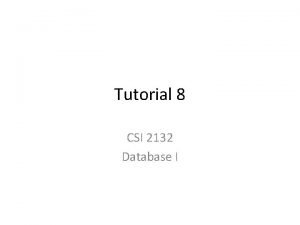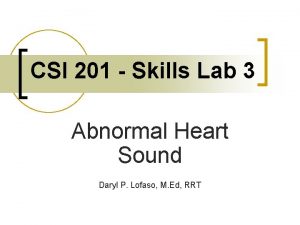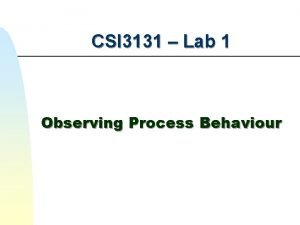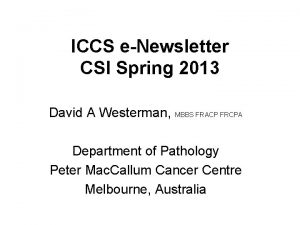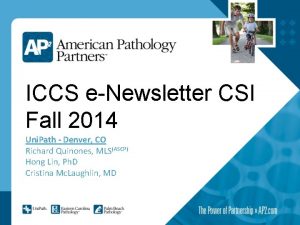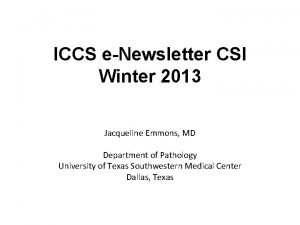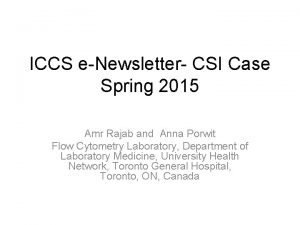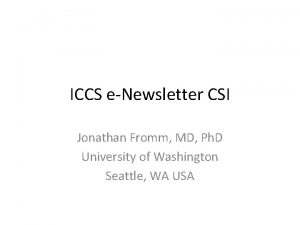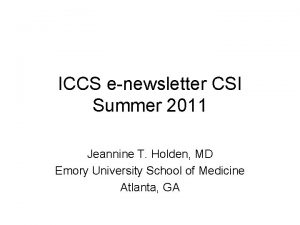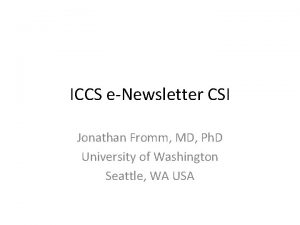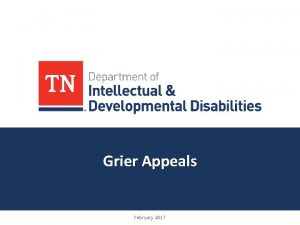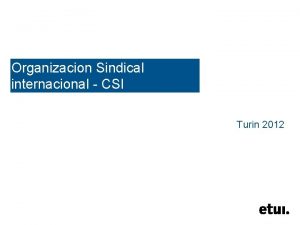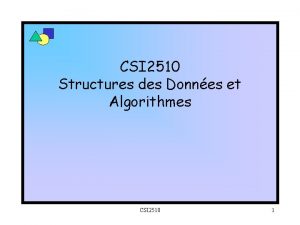ICCS eNewsletter CSI Fall 2010 David D Grier























- Slides: 23

ICCS e-Newsletter CSI Fall 2010 David D. Grier, M. D. Department of Pathology. Wake Forest University

e-CSI - Clinical History: • 61 year old man with no significant past medical history presented to his primary care physician complaining of fatigue, easy bruising, mild dyspnea on exertion, and headache for 3 weeks.

e-CSI - Peripheral Blood: • CBC – – – – – WBC: 24. 0 x 109/l RBC: 3. 51 x 1012/l Hgb: 11. 2 g/dl Hct: 31. 5 % MCV: 89. 8 fl MCH: 32. 0 pg MCHC: 35. 6 g/dl RDW: 15. 4% Plts: 19. 0 x 109/l Normal Range (4. 8 – 10. 8) (4. 7 – 6. 1) (14. 0 – 18. 0) (42. 0 – 52. 0) (80. 0 – 94. 0) (27. 0 – 31. 0) (33. 0 – 37. 0) (11. 5 – 14. 5) (160 – 360)

e-CSI - Peripheral Blood: • CBC Differential – Granulocytes: – Bands: – Lymphocytes: – Monocytes: – Basophils: – Eosinophils: – Blasts/Promyelocytes: 11% 1% 6% 1% 2% 0% 72%

e-CSI – Clinical History • Bone marrow aspirate and biopsy were received for evaluation. • Flow cytometric immunophenotyping was performed on a portion of the bone marrow aspirate and the results from selected 3 color and 5 -color tubes are provided for review.

e-CSI - Flow Cytometric Studies • Acquired with a FC 500 and initially analyzed with CXP Analysis 2. 0 and then with FSC Express version 3 • Tube 1: CD 34~FITC/ CD 2~PE/ CD 117~PC 5/ CD 45~PC 7 • Tube 2: CD 7~FITC/ CD 33~PE/ CD 45~PC 7 • Tube 3: HLA-DR~FITC/ CD 13~PE/ CD 45~PC 7

e-CSI - Flow Cytometric Analysis Large population of atypical cells with increased side scatter. There are very few events in the “blast gate”.

e-CSI - Flow Cytometric Analysis The atypical cell population has uniform expression of CD 33

e-CSI - Flow Cytometric Analysis There is no expression of HLA-DR and variable expression of CD 13.

e-CSI - Flow Cytometric Analysis There is expression of CD 2 and CD 34.

e-CSI – Key immunophenotypic findings • The atypical cells have high side scatter and fall in the “myeloid gate”. • Few events are seen in the “blast gate”. • The cells express CD 34, CD 117, and CD 2. • CD 13 expression is heterogenous. • CD 33 expression is homogenous. • There is no expression of HLA-DR.

Numerous atypical cells were seen. The nuclei were indented and overlapping. Few cytoplasmic granules were seen. No Auer rods were identified.

The bone marrow core biopsy was 100% cellular with the marrow space almost completely replaced by blasts.

Two fused signals, one red and one green, indicating the fused PML-RARA (yellow). Molecular cytogenetic analysis with DNA probes specific for the 15; 17 translocation [PML-15 q 22 and RARA-17 q 21] was performed and revealed that a total of 82. 5% of the interphase nuclei had a PML/RARA fusion event.

e-CSI Fall 2010– Diagnosis • Acute promyelocytic leukemia (APL), microgranular variant (Acute myeloid leukemia with t(15; 17)(q 22; q 12)).

e-CSI – APL characteristic immunophenotype • Absent or low expression of HLA-DR, CD 34, CD 11 a, CD 11 b, CD 15, and CD 64. • Homogenous expression of CD 33 • Heterogenous expression of CD 13 • Expression of CD 117, but it may be weak. • CD 56 is seen in approximately 20% of cases.

e-CSI – APL characteristic immunophenotype • Strong myeloperoxidase expression. • Microgranular variant can express CD 34 and CD 2. • By CD 45/side scatter the leukemic cells are typical found in the “myeloid gate”. Occasionally there is a “hockey stick” configuration. Microgranular variant tends to have lower side scatter.

e-CSI – APL characteristic immunophenotype • Lack of HLA-DR and CD 34 is not specific for APL and can be seen in other types of acute myeloid leukemia. • Immunophenotyping can suggest a diagnosis of APL, but it is NOT diagnostic.

e-CSI – APL clinical presentation • Fatigue, weakness, and dyspnea related to anemia. • Easy bruising or bleeding caused by thrombocytopenia or coagulopathy. • Most cases present with pancytopenia. – Microgranular variant can have very high WBC counts. • Risk of disseminated coagulopathy.

e-CSI – APL Diagnosis • Suspicion for APL is typically raised by morphologic assessment. – Abnormal promyelocyte morphology – Abundant cytoplasmic granules – Microgranular/hypogranular variant can have few to no visible granules. – Frequent Auer rods – Irregular nuclei: bilobed and kidney shaped. • More frequently seen in microgranular variant. • The diagnosis is confirmed by cytogenetics (FISH).

e-CSI – APL Differential diagnosis • Acute myeloid leukemia – HLA-DR negative leukemia is not limited to APL – Cytogenetics essential for diagnosis – APL is sometimes mistaken, especially the microgranular variant, for monocytic leukemia due to the nuclear features • Growth factor effect – Lower blast counts – Lacks atypical nuclei – No t(15; 17) abnormality

e-CSI – APL Treatment • The correct diagnosis is essential since the treatment is very different from other types of AML. • Treatment consists of all-trans retinoic acid (ATRA) and anthracycline-based chemotherapy for induction and ATRA plus arsenic trioxide for consolidation. • Some cytogenetic variants are ATRA resistant. – ZBTB 16 (11 q 23), STAT 5 B (17 q 11. 2)

e-CSI – references • • • Nagendra S, Meyerson H, Skallerud G, et al. Leukemias resembling acute promyelocytic leukemia, microgranular variant. American journal of clinical pathology 2002: 117(4): 651 -657. Orfao A, Chillon MC, Bortoluci AM, et al. The flow cytometric pattern of CD 34, CD 15 and CD 13 expression in acute myeloblastic leukemia is highly characteristic of the presence of PML-RARalpha gene rearrangements. Haematologica 1999: 84(5): 405 -412. Redner RL. Variations on a theme: the alternate translocations in APL. Leukemia 2002: 16(10): 1927 -1932.
 Eliza ann grier
Eliza ann grier Joseph w. grier academy
Joseph w. grier academy Diagrama de grier
Diagrama de grier Grier academy
Grier academy Iccs denver
Iccs denver Rbc normal range
Rbc normal range Iccs
Iccs Iata iccs
Iata iccs Iccs 2016 cytometry
Iccs 2016 cytometry After the fall 2010
After the fall 2010 Csi 101
Csi 101 While the csi team is searching the crime scene, _____.
While the csi team is searching the crime scene, _____. Csi epbb calculator
Csi epbb calculator Csi lewis structure
Csi lewis structure Csi
Csi Csi human resources
Csi human resources Csi 3531
Csi 3531 Elg2911
Elg2911 Csi enterprises inc
Csi enterprises inc Csi 3120
Csi 3120 Csi 2132
Csi 2132 Diastolic murmur with opening snap
Diastolic murmur with opening snap Csi 3131
Csi 3131 Csi varese
Csi varese





